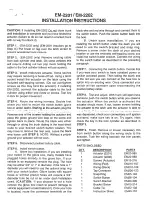
WARNING:
The camera(s) and sensors
associated with Forward Collision
Warning are designed to monitor an
approximate area of up to 525 feet
(160 meters) in your driving path. The
area being monitored by Forward
Collision Warning can be adversely
affected by road and weather
conditions. Use appropriate caution
when driving.
WARNING:
Forward Collision Warning
is designed only to provide visual and
audible alerts. It does not attempt to
apply the brakes or decelerate
Model X. When seeing and/or hearing
a warning, it is the driver's
responsibility to take immediate
corrective action.
WARNING:
Forward Collision Warning
may provide a warning in situations
where the likelihood of collision may
not exist. Stay alert and always pay
attention to the area in front of
Model X so you can anticipate
whether any action is required.
Forward Collision Warning operates only
when driving between approximately 3 mph
(5 km/h) and 90 mph (150 km/h).
WARNING:
Forward Collision Warning
does not provide a warning when the
driver is already applying the brake.
Automatic Emergency Braking
Model X is designed to determine the
distance from a detected object traveling in
front of it. When a frontal collision is
considered unavoidable, Automatic
Emergency Braking is designed to apply the
brakes to reduce the vehicle's speed and
therefore, the severity of the impact. The
amount of speed that is reduced depends on
many factors, including driving speed and
environment.
When Automatic Emergency Braking applies
the brakes, the instrument panel displays a
visual warning and sounds a chime. You may
also notice abrupt downward movement of
the brake pedal. The brake lights turn on to
alert other road users that you are slowing
down.
Emergency braking in
progress
Automatic Emergency Braking operates only
when driving between approximately 3 mph
(5 km/h) and 90 mph (150 km/h).
In addition, your vehicle may apply the
brakes, regardless of driving speed, to
prevent or mitigate a subsequent impact after
an initial collision.
Automatic Emergency Braking does not
apply the brakes, or stops applying the
brakes, when:
• You turn the steering yoke sharply.
• You press and release the brake pedal
while Automatic Emergency Braking is
applying the brakes.
• You accelerate hard while Automatic
Emergency Braking is applying the
brakes.
• The vehicle, motorcycle, bicycle, or
pedestrian is no longer detected ahead.
Automatic Emergency Braking is always
enabled when you start Model X. To disable it
for your current drive, touch
Controls
>
Autopilot
>
Automatic Emergency Braking
.
Even if you disable Automatic Emergency
Braking, your vehicle may still apply the
brakes after detecting an initial collision to
reduce further impact.
WARNING:
It is strongly
recommended that you do not disable
Automatic Emergency Braking. If you
disable it, Model X does not
automatically apply the brakes in
situations where a collision is
considered likely.
WARNING:
Automatic Emergency
Braking is designed to reduce the
severity of an impact. It is not
designed to avoid a collision.
Collision Avoidance Assist
143
Active Safety Features
















































